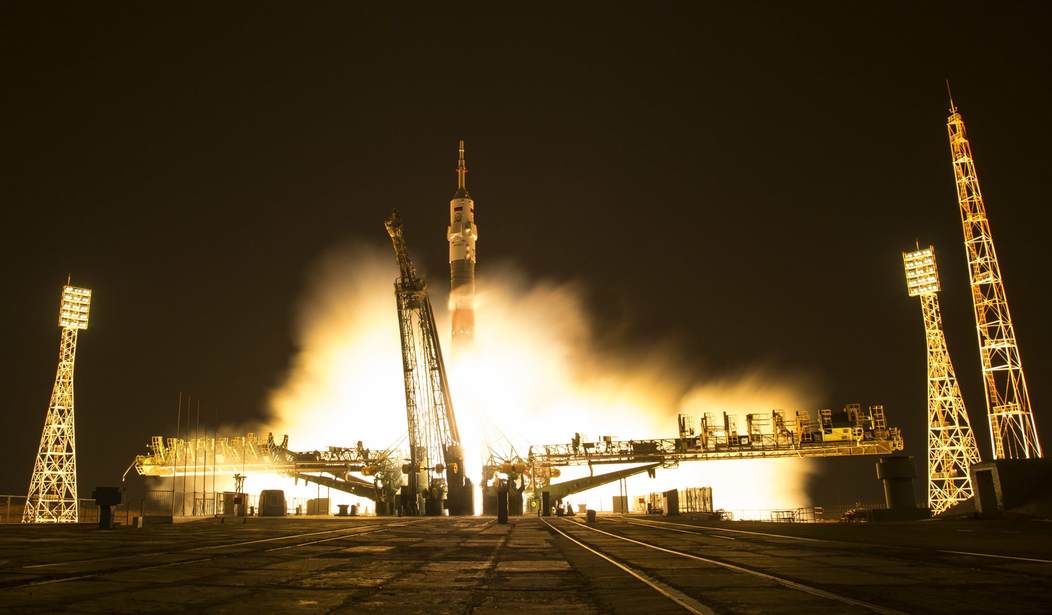WASHINGTON – Maj. Gen. Charles Bolden, Jr. (USMC-Ret.), the head of NASA, told PJM that the U.S. government pays Russia roughly $70 million per seat for astronauts’ trips to the International Space Station because of insufficient funding from Congress starting in 2010.
Bolden said the U.S. would have been “free” of relying on the Russians for space travel in 2015 with the proper funding for NASA’s Commercial Crew Development program.
NASA’s current $490 million contract with Russia runs through 2019.
“It will change – the new administration doesn’t have anything to do with it. It will change if the new administration continues on the path that the Obama administration has had us and this, to be quite honest, as a member of the Obama administration, I credit the Bush administration with saying, ‘OK, we’re going to phase out the Columbia, we’re going to phase out the shuttle and we’re going to let American industry provide transportation for our crews to and from space.’ That was directed in 2004. It’s a combination of Congress not appropriating the funds in a timely manner,” Bolden said during an interview Dec. 14 at a screening of the movie “Hidden Figures.”
“We should have been free of the Russians in 2015, but it took us all that time to finally get Congress on board with funding the commercial crew program. We now have it. We’re two years behind and we’ll get there,” he added.
“Hidden Figures” tells the story of the African-American women who did calculations for the Mercury Seven flights and Apollo 11. They worked on the missions at West Area Computers, a segregated division of the Langley Research Center.
Bolden said the U.S. does not yet have the capability to rely on the private sector for travel to the International Space Station.
“You know, the good thing about what we’re doing is we’re allowing industry an opportunity to learn how to do this – to do tests and everything and to build vehicles that are going to be reliable. It would be great if we could just say, ‘OK, we’re not going to pay the Russians another dime.’ Then that would mean we’re going to sit on the ground until we have commercial spacecraft available here,” he said. “If Congress had fully appropriated the funds back in 2010 when the president requested them, we would not have been flying with Russians now. We would have been flying with Boeing and SpaceX – that didn’t happen.”
Bolden explained that it took until 2014 to “start getting real serious funds” for commercial crews.
“So we are a little bit behind, but we’ll get there. I have no less faith in our industry. Boeing and SpaceX are really good. We’ve got another company called Sierra Nevada that has a vehicle that is a future candidate for carrying crews to space and it’s a winged vehicle, so it represents a different type of vehicle for getting people back from low Earth orbit for types of contingencies that you actually wouldn’t want to have to rely on a capsule,” he said.
“The American public has to be patient; you know, they didn’t get interested enough to push Congress to fund it when the president asked for it so now, you know, we’ve got to suffer the consequences of delaying and funding,” he added.
Bolden made a prediction about the future of launching American astronauts into space.
“My prediction, and I’m not in the prediction business, is that in late next year, early 2018, you’ll see both SpaceX and Boeing fly their un-crewed test missions on their crewed vehicles, and sometime in 2018 we’ll launch American astronauts from the Kennedy Space Center, Space Coast, and we’ll be launching from there from here on out,” he said. “We’ll still be launching with our partners from Russia, but our primary means of getting people to space will be from the Kennedy Space Center.”
Following the interview, PJM asked Bolden’s spokeswoman, Stephanie Schierholz, what Bolden would like to see NASA accomplish under the Trump administration.
“NASA will continue to send astronauts to conduct important research on the space station; launch several important science missions, including the James Webb Space Telescope to study the universe and the InSight and Mars 2020 missions to the Red Planet; see commercial partners SpaceX and Boeing begin operating commercial crew spacecraft; and conduct the first flight of the Space Launch System rocket and Orion spacecraft on an uncrewed test mission,” she said in a statement.
“The NASA community is patriotic and service oriented. Our employees, contractors, and partners alike take very seriously our role as the public’s servants. We are committed to doing whatever we can to assist in making the Executive Branch transition a smooth transition. NASA’s culture is apolitical as are the issues we tackle. Even during a contentious election year, we saw bipartisan support for our work on priorities, such as Commercial Space,” she added.
Schierholz wrote that NASA anticipates that leaders in and out of government will remain enthusiastic about the agency’s work.
“There is a consensus that has been emerging in the scientific and policy communities around NASA’s Journey to Mars; specifically around our plan, timetable and strategy for sending human beings to Mars in the 2030s. There is widespread recognition that NASA’s plan is clear, affordable, sustainable and attainable,” she said.
“This consensus is stretching not only across the aisle, but across the public, private, academic and nonprofit sectors. Our international partners have expressed enthusiasm for the Journey to Mars. In an email to NASA employees Nov. 9, Administrator Bolden cited progress on Earth Science, Aeronautics, exploration of our Solar System & Beyond, the International Space Station, Technology, and the Journey to Mars as examples,” she added.









Join the conversation as a VIP Member